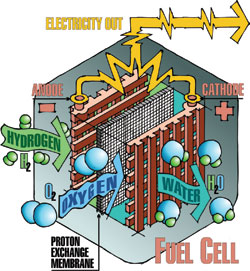Renewable Hydrogen Goes Maine-stream
Although it is the lightest element on the planet, liberating hydrogen from its molecular bonds can be a dirty process. However, a $250,000 demonstration project recently unveiled in Maine may be the bridge that leads to a clean hydrogen future.

The Chewonki environmental education center’s hydrogen generator runs solely on renewable energy from the solar panels on its roof and hydroelectric dams. The electrolyzer provides backup power for the visitor’s center.
According to the National Hydrogen Association, more than 96 percent of the four million kilograms of hydrogen that the U.S. currently produces every day is derived from fossil fuels. Less than four percent of U.S. hydrogen is produced through electrolysis—a process that uses electricity to break down water into pure hydrogen and oxygen. Unfortunately, the majority of these systems depend on large amounts of non-renewable energy.
In August, the Chewonki Foundation’s environmental education center in Wisacasset, Maine unveiled the nation’s first hydrogen back-up system (taking over when grid power fails), and running completely on renewable energy. It is also the first publicly accessible direct high-pressure electrolyzer system.
“Hydrogen can replace fossil fuels, and we’re in a good position because Maine is rich in renewable resources,” says Peter Arnold, project director at the Chewonki Renewable Hydrogen Project. “The real world use for this system is back-up power.”
The Chewonki hydrogen system is capable of providing back-up power for the 11,000 square-foot visitor’s center for four days in the event of a power outage. Energy sourced from solar panels installed on the center’s roof mixes with “green power” purchased from hydroelectric dams in the state before entering into a Connecticut-built Avalence electrolyzer. What makes this electrolyzer novel is that it generates hydrogen at high pressures, eliminating the need for costly compressor and moisture control equipment. Once stored, the hydrogen is then used to charge the system’s three one-kilowatt fuel cells.
“Hydrogen-powered fuel cells are theoretically another type of battery,” says Paul Faulstich, Chewonki project manager, but “fuel cells are much more efficient in storage capacity and more consistent in voltage than batteries.”
Maine’s system is currently the vanguard of a huge potential market. “There is a significant market in back-up power systems for hydrogen,” says Patrick Serfass, director of programs and technology development at the National Hydrogen Association. “There are more than 200,000 cellular towers in the U.S. hosting an average of 2.5 carriers in need of the back-up power that these hydrogen systems can provide,” Serfass says. For the many supporters of hydrogen energy, back-up power is just the beginning.
CONTACTS
Avalence, (203) 701-0052, www.avalence.com
Chewonki Foundation, (207) 882-7323, www.chewonki.org.

